
There are many market gardens and orchards in this area of Ontario and Quebec where much of the fallout appears to have headed. Citizens in Ontario are reporting black particles on snow in their yards and headaches and in Montreal, Quebec, week long nose bleeds.
Wearing an N95 when outside would help limit some of the toxic particles inhaled. Best to stay indoors, if possible, and limit pets’ time outside. There is no way to protect livestock or food lands and farms, or parks and home gardens. I wouldn’t eat any foods grown in these areas – commercial or home gardens – this next growing season, perhaps not even for a few years. I expect wildlife, bird and fish deaths also in Canada, and health impacts for pets and people. Particulate pollution like this makes COVID-19 much more deadly.
I also expect the rich and powerful will be forcing through more deregulation to enable more deadly fumes spread over many more communities and for their crimes of greed to be legally immune. And instead of warning the public to protect themselves with N95s or better, pushing our corporate controlled media to lie to the public, say no harms done, concentration of toxic pollutants not enough to sicken anyone in Canada, quoting an academic at a university that gets mega cash gifts (aka bribes) from the corporate world.
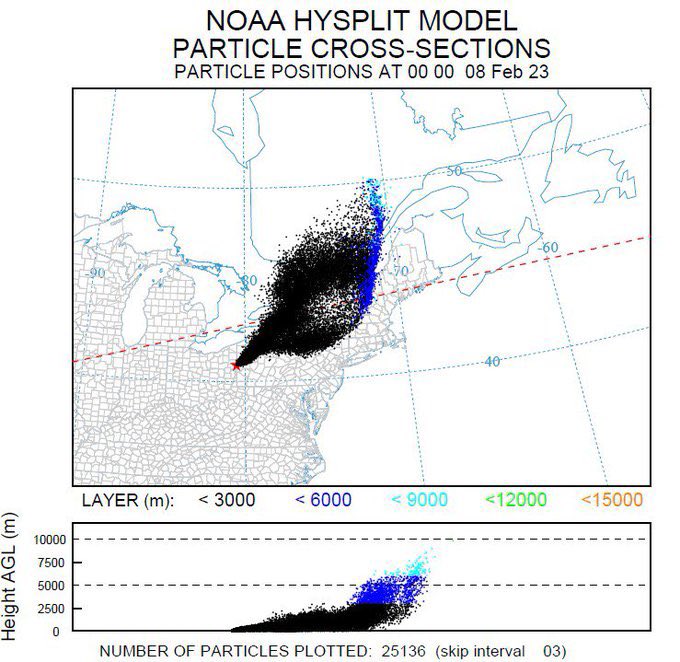
Above from: Dispersion Of Chemicals Using NOAA’s HYSPLIT Model
From the NOAA Air Resources Lab: The Hybrid Single-Particle Lagrangian Integrated Trajectory model. This is used to track a single air particle to show how far and in what direction it travels. We have used this to plot the origin of arctic air, and even retroactively plot the suspected path of the Chinese Spy Balloon.
Here we can see the cloud spread with the wind to the North and Northeast. A high enough concentration was determined to have reached across northern Pennsylvania, Buffalo and Albany in New York, and beyond to Montreal in Canada.
@April_Sassy:
Only $5 per person. That would cover maybe 1 case of bottled water that each resident needs because the water isn’t safe for consumption right now.
***
USA Federal Railroad Administration Office of Safety Non-safety Analysis Database.
***

![]() Deregulation wins big for billionaires every time, while losing big for public health, families, drinking water, farms, communities, environment, livestock, pets, birds, fish, etc every time.
Deregulation wins big for billionaires every time, while losing big for public health, families, drinking water, farms, communities, environment, livestock, pets, birds, fish, etc every time.![]()
Ron Filipkowski @RonFilipkowski:
You are looking at the result of an order from a Republican Governor after declining federal assistance, and deregulation of the rail industry under Trump.
![]() Photos below are from sources various. Water contamination and the deadly fumes are spreading far and wide (reports from Canadians in Southern Ontario, including in Niagara Falls and Toronto, smelling chemicals, suffering headaches, burning eyes, breathing difficulties and more):
Photos below are from sources various. Water contamination and the deadly fumes are spreading far and wide (reports from Canadians in Southern Ontario, including in Niagara Falls and Toronto, smelling chemicals, suffering headaches, burning eyes, breathing difficulties and more):![]()


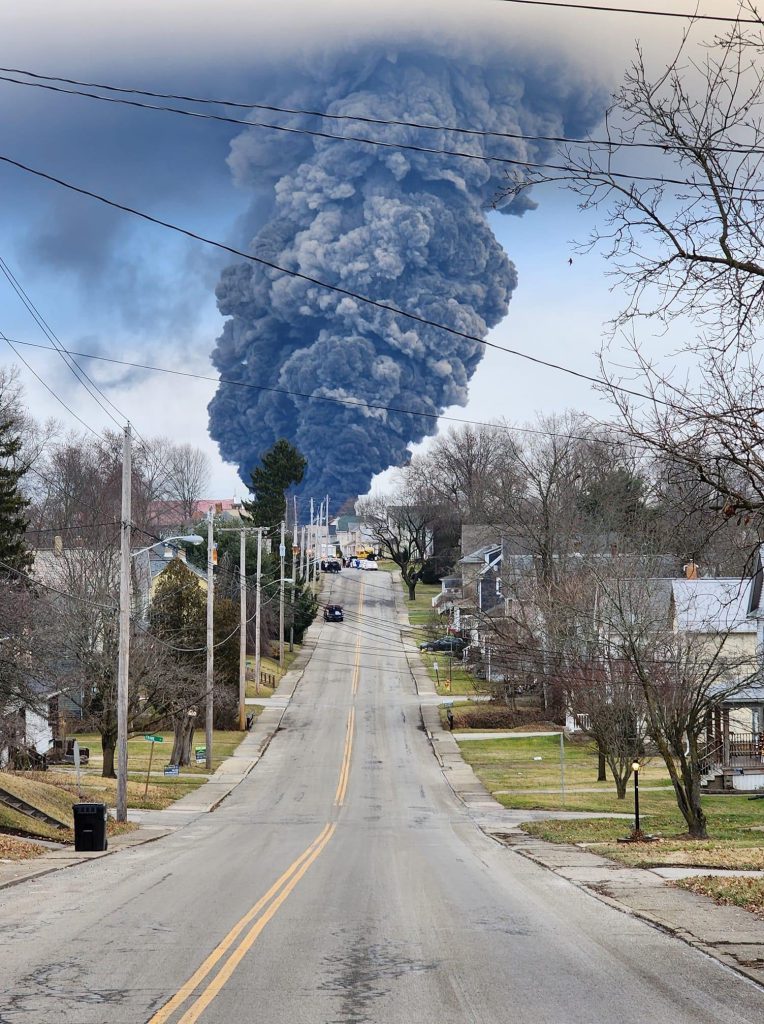
![]() Where will the toxic fumes go? How much drinking water has been/will be contaminated for how many in America and Canada? N95s or better might provide some protection.
Where will the toxic fumes go? How much drinking water has been/will be contaminated for how many in America and Canada? N95s or better might provide some protection.![]()
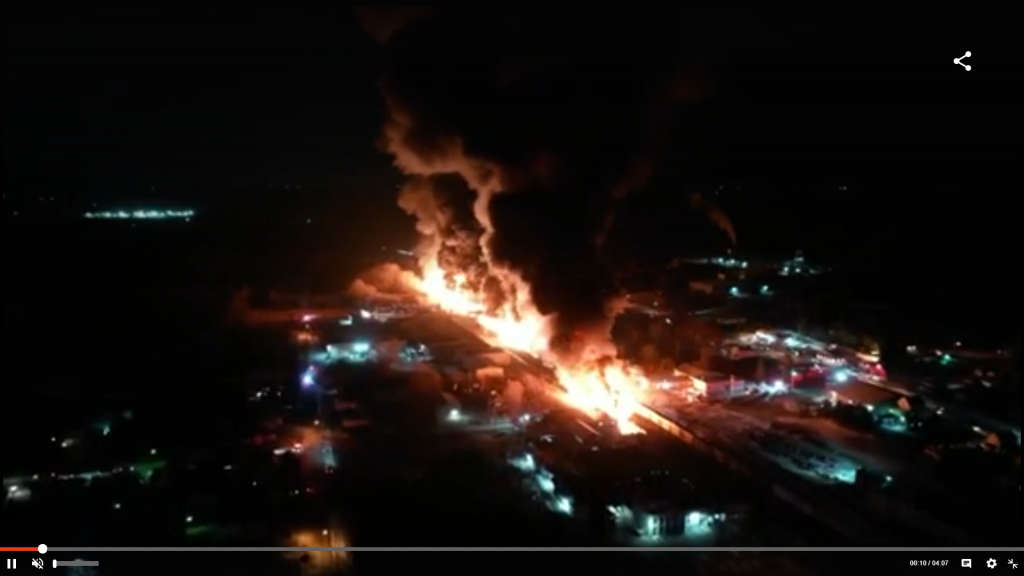
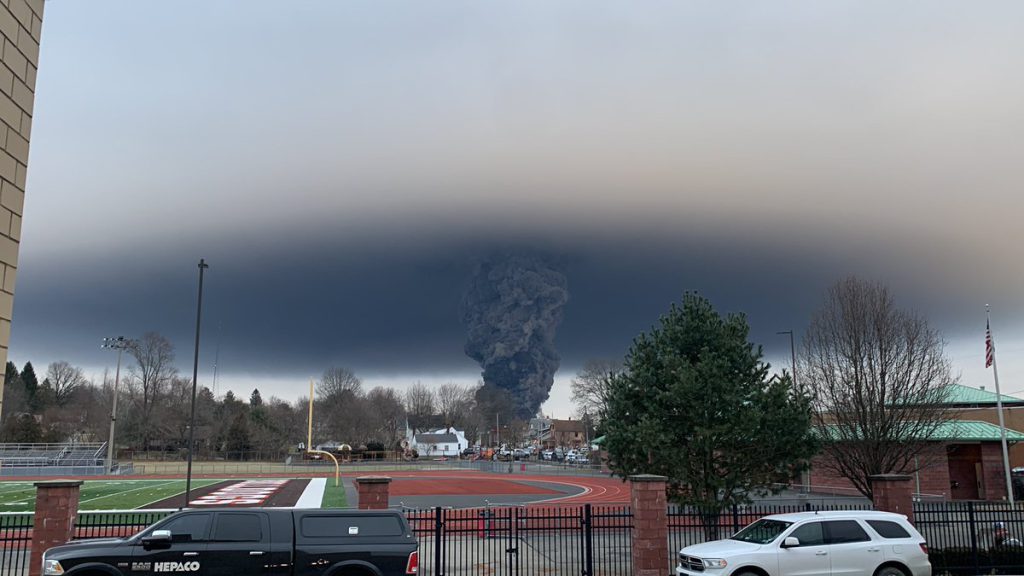
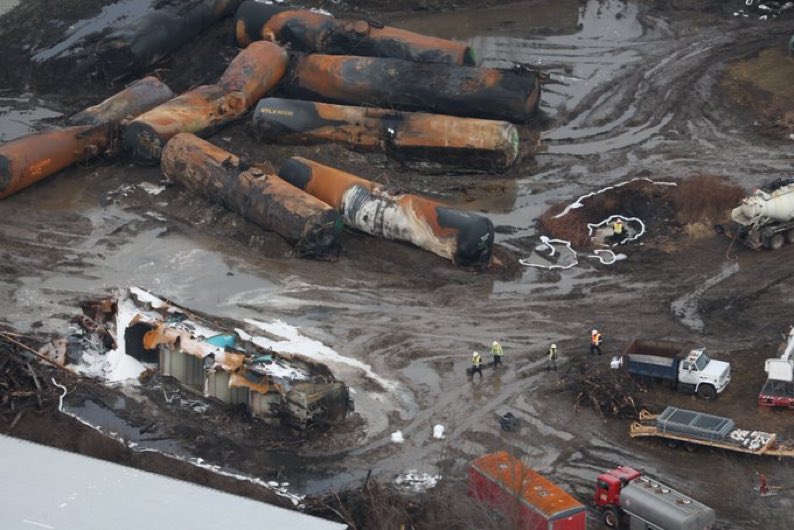


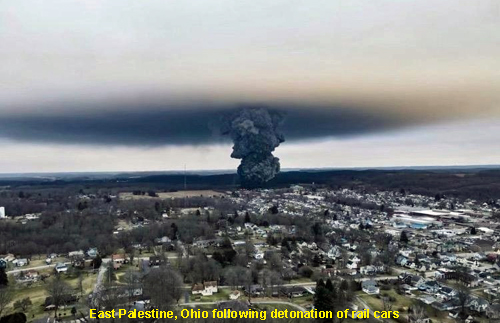

Taylor Holzer, fox-keeper in East Palestine, Ohio:
“Norfolk Southern Corp can’t get away with what they have done. Kirin is dead. The rest of my foxes are suffering.”

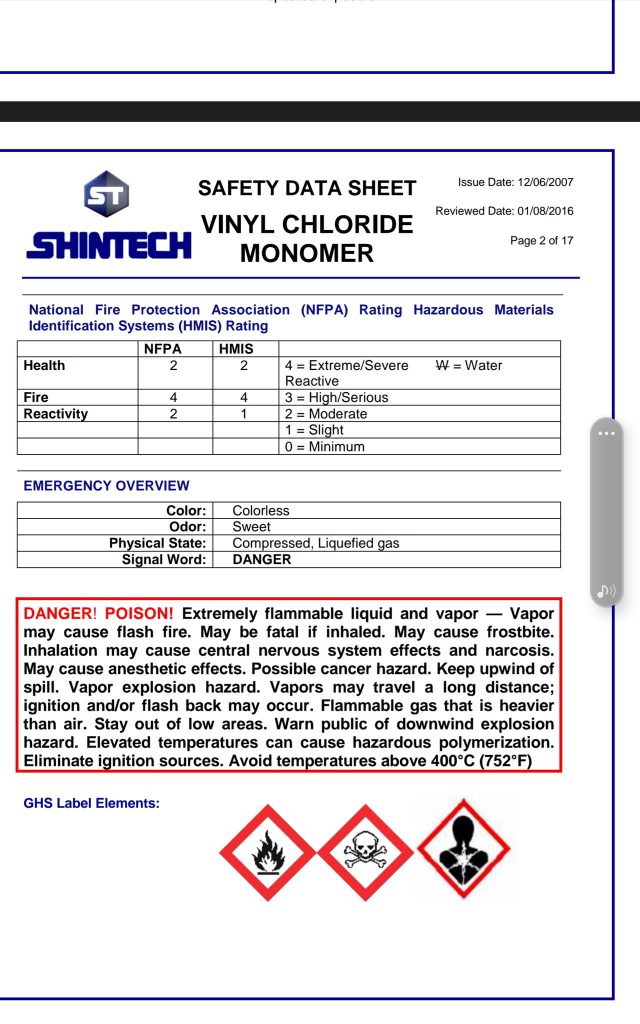
David Sirota@davidsirota:
Someone just told me there were no questions at today’s White House @PressSec
briefing about the unfolding Ohio disaster.
I didn’t see the briefing. Is that true?
Because if it is, it’s a sign that DC media is so obsequious it won’t even ask questions.
CommieAngel@Commie_Angel:
When Chernobyl happened, USSR evacuated the town. Every person was forced to leave. They were given new places to live & healthcare for the rest of their lives.
In Palestine Ohio, USA ppl are on their own. No hotel vouchers even. Nothing but lies & dead pets, & a scary future…
Josh Olson@joshuarolson:
10 days. No comment from the Secretary of Transportation.
Jared R. @jororofo:
Can you imagine being a human being who thinks it’s more important to protect your favorite politician’s reputation than it is to protect the thousands of lives being threatened by this disaster? I can’t.
REPORT: 30 Million People May be in Danger by East Palestine Disaster by Collin Rugg, February 13, 2023, Trending Politics ![]() How many have been/will be poisoned in Canada? How much foodland and water contaminated? How much livestock, wildlife, fish, birds sickened, killed?
How many have been/will be poisoned in Canada? How much foodland and water contaminated? How much livestock, wildlife, fish, birds sickened, killed?![]()
30 million people, or 10% of the United States population, may be in danger after a train derailed in East Palestine, Ohio that led to the release of toxic chemicals.
“We basically nuked a town with chemicals so we could get a railroad open,” said Sil Caggiano, a hazardous materials specialist.
As public officials try to calm the public, animals are falling sick and dying.
“Out of nowhere, he just started coughing really hard, just shut down, and he had liquid diarrhea and just went very fast,” said resident Taylor Holzer while he explained the mortally ill confition of his foxes.
“Smoke and chemicals from the train, that’s the only thing that can cause it, because it doesn’t just happen out of nowhere,” Holzer said.
“The chemicals that we’re being told are safe in the air, that’s definitely not safe for the animals … or people.”
According to a new report, the situation may become much more widespread through the Ohio River Basin.
As noted by Stew Peters, 10% of the United States population may be in trouble.
“10% of the U.S. population, over 30 MILLION PEOPLE, live in the Ohio River Basin!” he tweeted. “The Ohio River itself provides drinking water to over 5 MILLION PEOPLE!”
According to Upward News, the dangerous chemicals are making their way as far as West Virginia through the Ohio River.
“Toxic chemicals from the train derailment & explosion in East Palestine have reportedly “contaminated” the Ohio River as far as West Virginia, a water source for over 5 million,” they reported. ”
“The Ohio River is one of the nation’s great natural resources. Over 30 million people, or about ten percent of the U.S. population, live in the Ohio River Basin. With numerous public drinking water intakes and industries, the river provides drinking water to +5,000,000 people.”
… As noted by DC Draino on Twitter, the toxic acid rain cloud has a 200 mile radius however people are only being evacuated in a 1 mile radius from the crash site.
“They only evacuated people in a 1 mile radius of the Ohio train crash site,” he tweeted. “The toxic acid rain cloud has a 200 mile radius (that we know of). Now you know why the media won’t talk about this disaster.”
‘We basically nuked a town’: 3 more chemicals discovered in Ohio train derailment by Jennifer Rodriguez, Feb 12, 2023, WKBN
First News was recently informed of three more chemicals that were on the Norfolk Southern train that derailed in East Palestine just over a week ago — and we are being told that those chemicals are dangerous.
“We basically nuked a town with chemicals so we could get a railroad open,” said Sil Caggiano, a hazardous materials specialist.
The U.S. Environmental Protection Agency sent a letter to Norfolk Southern stating that ethylene glycol monobutyl ether, ethylhexyl acrylate and isobutylene were also in the rail cars that were derailed, breached and/or on fire.
Caggiano says ethylhexyl acrylate is especially worrisome. He says it’s a carcinogen and contact with it can cause burning and irritation in the skin and eyes. Breathing it in can irritate the nose and throat and cause coughing and shortness of breath.
Isobutylene is also known to cause dizziness and drowsiness when inhaled.
“I was surprised when they quickly told the people they can go back home, but then said if they feel like they want their homes tested they can have them tested. I would’ve far rather they did all the testing,” Caggiano said.
Caggiano says it’s possible some of these chemicals could still be present in homes and on objects until you clean them thoroughly.
“There’s a lot of what ifs, and we’re going to be looking at this thing 5, 10, 15, 20 years down the line and wondering, ‘Gee, cancer clusters could pop up, you know, well water could go bad,” Caggiano said.
Caggiano recommends anyone in the East Palestine area should get a health check-up. Get it on record where your health stands now so that moving forward you’ll have documented any effects possibly related to the train derailment.
Fox Dies in Owner’s Arms After Ohio Train Crash Releases Toxic Gas by Anna Skinner, Feb 10, 2023, Newsweek
An Ohio resident’s exotic animals are suffering a week after a train derailment caused a chemical spill of vinyl chloride.
The train derailment last week in East Palestine caused a massive fire and concerns over a possible explosion that would further release toxic gases and chemicals. The train cars carried vinyl chloride, a known carcinogen. The Environmental Protection Agency (EPA) placed monitors in the town, according to WFMJ. An evacuation order was placed and then eventually lifted, allowing people to return to their homes. However, one resident is still dealing with the devastating effects on his animals.
Taylor Holzer told Newsweek that he’s always loved animals. The East Palestine resident takes care of various animals, many of them rescues, including foxes, coyotes, squirrels, tortoises and exotic birds.
All of his foxes have been affected by the chemical spill. One fox died, and Holzer suspects it was from chemical exposure from the derailment.
“He went downhill very fast,” Holzer said, describing the fox as having symptoms such as diarrhea and breathing issues. “He crashed so fast and unexpectedly. He wasn’t able to blink or function properly as he died in my arms.”

Holzer lives near the evacuation zone but was just outside of it. Even though he wasn’t told to evacuate, he moved his parrots to a friend’s pet store nearby as birds are very sensitive to air quality. However, the property where he keeps the foxes and other animals was inside the evacuation zone. Holzer was unable to help them.
“By the time I was aware of the evacuation orders, it was too late to get them all of out of there,” he said. “Moving exotic animals isn’t as easy as just grabbing your house cat or dog and jumping in the car.”
His animals are still suffering from chemical exposure, and some of them are being treated at the Metropolitan Veterinary Hospital in Highland Heights. Expenses will be high.
Holzer paid $2,000 as a deposit for four sick foxes to stay at the vet. Expenses for the necropsy on the dead fox, tests for the living ones and other procedures are unknown. One fox broke its leg when fleeing after noises from the derailment caused it to panic, and Holzer isn’t certain how much its treatment will cost.
Holzer said the vet clinic is concerned about contamination from the affected foxes. Vets donned masks and asked Holzer to bring the sick foxes in through a separate entrance so any chemical particles on the foxes didn’t affect other animals or people.
“They didn’t have space or resources for more than the [four] that were impacted the worst,” Holzer said.
Holzer isn’t sure what the next steps are, but he knows he’s not the only animal owner suffering from the derailment. He said another Ohio resident’s cat had to be euthanized because of vinyl chloride poisoning. Other people lost chickens, and a hawk was found dead in a pasture.
“I feel so bad for the other animal owners that have to go through this and are losing parts of their family, and the wildlife that is suffering,” he said.
“Everyone needs to be reimbursed for what has happened somehow.”
![]() Northfolk Southern offers $5 per resident. Sign ‘n gag quickly please.
Northfolk Southern offers $5 per resident. Sign ‘n gag quickly please.![]()
One of Holzer’s friends launched a GoFundMe to raise money to cover the vet bills. The GoFundMe had raised nearly $16,000 as of 3:30 p.m. ET Friday afternoon.
Newsweek reached out to the Metropolitan Veterinary Hospital and the EPA for comment.
***
Evil is Banal, Bad Stuff Happens Whether You Focus on it or Not by Jessica Wildfire, Feb 12, 2023, OK Doomer substack
… A train carrying a bunch of toxic chemicals derailed in Ohio. The containment turned into a second disaster as an inversion layer trapped all those chemicals under the atmosphere. Instead of heading up and away, it’s now spreading over a large part of the country. There’s reports of animals dying 100 miles away. Journalists are getting arrested for trying to cover this one, so you know it’s got to be bad. I seem to remember railroad workers striking for better working and safety conditions, among other things. This is what happens when we allow the rich to do whatever they want. You get toxic plumes in your backyard. …
It’s not normal for toxic plumes to be spreading over the nation’s breadbasket in ways that will probably impact us for decades.
Yes, you really should probably invest in gas masks for your family now. How weird is it to say that out loud? How weird is it to say that, knowing that the reason isn’t a supervolcano or some conspiracy theory. It’s just a bunch of greedy billionaires, who have lost every ounce of concern for their fellow humans.
It’s like Hannah Arendt said, true evil isn’t Lex Luther super villains. It’s just people being petty, greedy, hateful, violent, and easily manipulated. …
***
Daniel T. Goldkamp@DanielTGoldkamp:
Sooooo… $5 to each person who had to evacuate their home?
Megan (she/her)@carenotcopsnyc:
The cancer, birth defects and long term damage might already be done. Think of bodies in post covid-long term covid and then give them toxic gas that is deadly to their lungs.
Sybil Wright @sybil_wright__:
Not even enough to pay for the gas they used to get away.
Then came 2017: After rail industry donors delivered more than $6 million to GOP campaigns, the Trump administration — backed by rail lobbyists and Senate Republicans — rescinded part of that rule aimed at making better braking systems widespread on the nation’s rails.
moconn@jpmmmom:
How horrible – will they throw a roll of paper towels at them too?
I_love_bread@scotdscher:
Omfg I thought for a second like an idiot that it was offering this per person.![]() Me too, and instantly thought $25,000 per resident is grossly insufficient, never mind a pathetic $5.
Me too, and instantly thought $25,000 per resident is grossly insufficient, never mind a pathetic $5.![]()
Hotep P@Zay_99__:
The multi billion dollar corporation could only muster up 25k for potential killing and causing long term health problems to thousands of people???
maserati:
A $25,000 business tax write off means that our tax dollars are actually paying for this so- called donation .Surprised it wasn’t more since it costs the business nothing, in the endgame.
Kristopher:
Like I always say corporations pay nothing while Americans pay for it all. What’s 25k to a whole town. Next they’ll get their EPA fines of ten bucks.![]() And appeal it, and appeal it, again and again and again, costing taxpayers millions in legal fees and court costs and in the end, the company will refuse to pay the ten dollar fine, if it is upheld on appeal.
And appeal it, and appeal it, again and again and again, costing taxpayers millions in legal fees and court costs and in the end, the company will refuse to pay the ten dollar fine, if it is upheld on appeal.![]() That’s how corporations work and this is how government works…they sccrew the ppl… we ddie they thrive..
That’s how corporations work and this is how government works…they sccrew the ppl… we ddie they thrive..
qdog112:
Oh boy $5 real America dollars per resident. Honey, we’re rich! Hitch up the horses we’re going into town.
Steve:
I live 8 miles away from this.. What a joke this Train Was on fire through 3 towns before it derailed 20 miles people have the video of it on security cameras I can’t even begin to explain the smoke and mess from this thing It looked like someone dropped a bomb ive never seen a mushroom cloud like it only in movie. People’s chickens are “mysteriously” dying all of the sudden.( birds are extremely sensitive to air quality) no one is telling us the truth even the locals news this is just the beginning
Just saying:
Don’t worry, the governor will talk to the courts and have the whole thing swept under the rug in no time. Of course he’ll except a generous donation from Norfolk and Southern for his next political scheme.
John:
Ohio EPA? Hmmm, do I trust Ohio’s government? Not after years of republican control, and Ohio’s EPA telling residents the air and water was safe reminds me of w’s EPA head (christine todd whitman) telling America the air was safe around ground zero. How has that worked out for the first responders who are sick or have died from working in that toxic environment with paper masks that did about as much as a handkerchief over their faces. Great red party leadership there w, whitman, and especially rudy buffooniani who put those workers in that environment with no breathing protection. Another great example of red party leadership is snyder, Flint Michigan poisoned water. Two snyder top aides, Michael Gadola and Valerie Brader warned snyder a year (or more) about it. Yet he tried to sweep it under a rug for (I think) 14 months. There have been untold numbers of oil spills and it’s always the red party who fight for the polluters over health concerns of the people. …
Norfolk Southern is giving $25,000 to an Ohio town where it caused a life-or-death evacuation by Julia Malleck, February 9, 2023, Quartz, Yahoo Finance
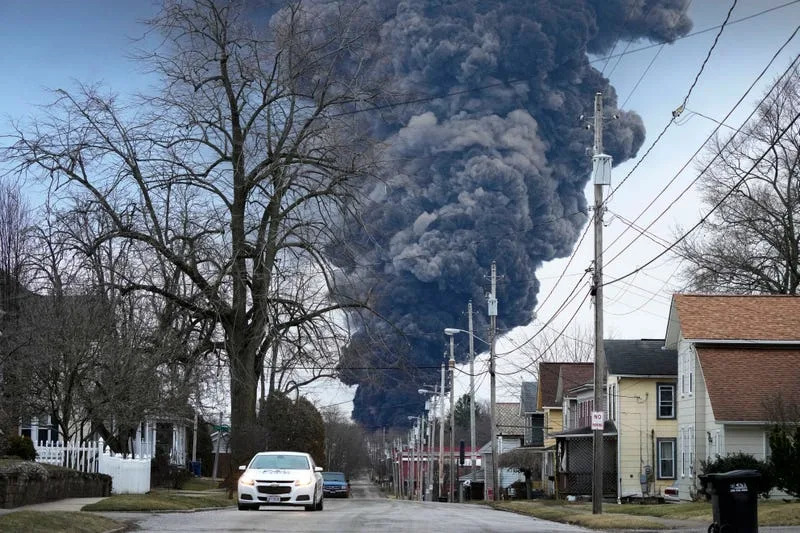
A dark cloud rises over East Palestine, Ohio.
On Feb. 6, an apocalyptic plume of gas rose over the village of East Palestine, Ohio, blotting out the sky. Norfolk Southern, the US railway company responsible for the toxic spew of vinyl chloride, has now offered a $25,000 donation to assist the area’s nearly 5,000 residents who were ordered to evacuate their homes, or face death.
“We have established a Family Assistance Center to address the needs of the community and support those directly impacted,” Norfolk Southern said in a statement. It remains unclear what exactly the center is doing to assist displaced residents. Quartz has reached out for a comment.
Following its fiery derailment on Feb. 3, a Norfolk Southern tanker train carried out a “controlled release” of the hazardous vinyl chloride stored aboard to avoid a potential explosion.
The derailment was reportedly due to a mechanical problem, but some are blaming the incident on weak safety regulations and the company’s cost-cutting measures.
Regulation pushback, cuts in headcount
Norfolk Southern has a history of lobbying against safety regulations. The publicly traded company, which has a market value of $55 billion, fought the Federal Railroad Administration’s push to upgrade the “Civil War era” brake system that remains widely used in American trains, and against stricter rules on the transport of hazardous materials. (Meanwhile, its employees still lack guaranteed sick leave.)
Safety concerns have also grown amid Norfolk Southern’s implementation of “precision scheduled railroading,” an operations policy criticized as a corporate money grab. To cut costs, the company has slashed jobs by more than a fifth since 2017, ignoring concerns that understaffing could impact railway safety, while also initiating a $10 billion stock buyback program.
Millions of dollars in corporate lobbying and poor regulations have created the perfect storm, according to Railroad Workers United (RWU), a cross-union rail workers’ caucus.
“The wreck of Train 32N has been years in the making. What other such train wrecks await us remains to be seen,” RWU said in a press release.
Is East Palestine, Ohio safe?
The National Transportation Safety Board has opened an investigation into the train derailment, while a federal lawsuit seeking class-action status has been filed by several East Palestine residents.
Government officials told evacuated residents of the Ohio-Pennsylvania area on Feb. 8 that they could safely return to their homes, based on air quality samples. The Ohio Environmental Protection Agency has also declared the area’s drinking water is safe.![]() Is Ohio EPA trustworthy? I don’t think so.
Is Ohio EPA trustworthy? I don’t think so.![]()
But concerns remain. Residents have found dead fish in a local stream called Leslie Run, and dead chickens were found in the neighboring town of North Lima, Ohio. Kurt Rhoads, an environmental engineer and associate professor at Ohio’s Case Western Reserve University, told Cleveland 19 News that the impact from the derailment would be felt for years to come.
One community in New Jersey can attest to that fact. In 2012, a train crashed in Paulsboro, spilling 23,000 gallons of vinyl chloride, the same chemical involved in the East Palestine spill. A 2014 study conducted by the New Jersey Department of Health found that half of local residents had health problems caused by the chemical spill.
What are the health risks from vinyl chloride?
When burned, vinyl chloride produces hydrogen chloride, a highly volatile substance that can bind with water vapor to produce hydrochloric acid. It can also produce phosgene, a toxic gas that was deployed as a chemical weapon in World War I.
Aside from its toxic byproducts, the odorless and hazardous gas not only lingers in the air, but also can leach into soil and groundwater (pdf). According to the CDC’s toxicological profile, vinyl chloride is linked to liver and neurological damage (pdf) as well as several types of cancer.
OSHA guidelines state that no employee should be exposed to the substance at concentrations higher than 1 part per million averaged over an eight-hour period.
Angelina (No My Name’s Not) Libby@anglib78:
So they’re poisoning the air AND insulting ppl.![]() It’s the Billionaire Way.
It’s the Billionaire Way.![]()
I_love_bread@scotdscherL
This is almost worse in a way than giving nothing.![]() It’s much worse; I think the company is using the $5 to eventually trick and gag everyone.
It’s much worse; I think the company is using the $5 to eventually trick and gag everyone.![]()
***
Dave S@Deedubbayous:
These tankers contain Vinyl Chloride! A potent human carcinogen. I pitty the residents of this town, I would not want to be anywhere near this accident now or anytime in the future. This is some really nasty stuff everyone around there is going to be developing cancer!
David Sirota@davidsirota:
BREAKING: After Ohio derailment, @SecretaryPete has no plans to reinstate Obama’s brake rule, despite a warning to Congress that without it “there will be more derailments.”
Buttigieg’s DOT is now considering a proposal that may weaken safety rules.![]() What safety rules? Even when there are rules that escape industry’s greed and demands for deregulation which regulators happily bend over to grant, regulations are rarely enforced. When enforced, fines are so tiny that polluters laugh as they pocket their $billions in profits. And, even the few tiny fines that are issued, companies just don’t pay. Regulators know this, yet continue to grant deregulation demand after deregulation demand, and politicians keep stealing from the citizenry to make us pay to keep polluters poisoning us in our homes and communities.
What safety rules? Even when there are rules that escape industry’s greed and demands for deregulation which regulators happily bend over to grant, regulations are rarely enforced. When enforced, fines are so tiny that polluters laugh as they pocket their $billions in profits. And, even the few tiny fines that are issued, companies just don’t pay. Regulators know this, yet continue to grant deregulation demand after deregulation demand, and politicians keep stealing from the citizenry to make us pay to keep polluters poisoning us in our homes and communities.![]()
Sarah ten Bensel@sarah_bensel:
Also paying for lawsuits and dead people are cheaper. Environment be damned also. Perhaps Pete and his department would reconsider, but….$$$$ and political future
@PoliticsJunkieT:
Don’t worry, a fine will be paid ![]() maybe
maybe![]() and absolutely no lesson will be learned
and absolutely no lesson will be learned![]() Except to deregulate more for the profit raping corporations while taking away yet more rights from the citizenry and press.
Except to deregulate more for the profit raping corporations while taking away yet more rights from the citizenry and press.![]()
Caitlin@csommerville1:
I can’t believe they’re trying to cover it up!!!! ![]() That’s the corporate name of the game, enabled by our politicians, courts, and regulators. In Canada too.
That’s the corporate name of the game, enabled by our politicians, courts, and regulators. In Canada too.![]() That makes it 100000x WORSE! Ugh
That makes it 100000x WORSE! Ugh
Mr. Wap Kon Jorge @Wopkonjorge:
Pete Buttigieg is a for real super villian.![]() They’re everywhere, notably in politics, on the courts, in law firms, and working to deregulate at self-regulators and lobby groups spewing their vile lies and propaganda. Also everywhere in Canada helping the rich get richer while actively destroying this magnificent planet’s ability to sustain human life, and that of many other species.
They’re everywhere, notably in politics, on the courts, in law firms, and working to deregulate at self-regulators and lobby groups spewing their vile lies and propaganda. Also everywhere in Canada helping the rich get richer while actively destroying this magnificent planet’s ability to sustain human life, and that of many other species.![]()
Maya Loves You@tssexymaya:
How does it help by making the problem worse? I’d love to understand the logic behind all this.
Chris @nightsky56:
Secretary of Corporate Profits
its still a Pandemic, folks!@HTTOrganizers:
OF COURSE HE IS. This is the guy whose first job out of college was advising Insurance companies how to “cost cut” by cheating patients out of still more care. Check his presidential campaign chest for Train company donations.
Beckii Staxx@JawnWicksWife:
I live about an hour from there, just inside Allegheny County. We have all been fighting the government over these ‘bomb trains’ and the cracker plant. Nobody cares. Is all about money in their pockets.
holler@Hisham18754:
The fact that all the pollution and damages from this will be be fixed with government money make it easier for these companies to avoid spending money on safety.![]() Except much of the pollution and damages are irreparable. Industry’s and humanity’s greed-fed toxic pollution keeps on accumulating in our drinking water, foods, clothing, housing, etc and environment, our bodies and in the bodies of other species. What I haven’t been able to understand for decades now, is why humans keep intentionally making babies, forcing their offspring into a toxic cesspool. I would never do that to another being. Watch the clip below, again, especially if you are a lying authority or company rep.
Except much of the pollution and damages are irreparable. Industry’s and humanity’s greed-fed toxic pollution keeps on accumulating in our drinking water, foods, clothing, housing, etc and environment, our bodies and in the bodies of other species. What I haven’t been able to understand for decades now, is why humans keep intentionally making babies, forcing their offspring into a toxic cesspool. I would never do that to another being. Watch the clip below, again, especially if you are a lying authority or company rep.![]()
Munda Squire@MundaSquire:
It comes down to a basic question. Who rules the US? No sensible, honest person can say, the people.
We are not a democracy.![]() Neither is Canada. Foreign rich and multinational corporations run our politicians, regulators and courts here too. I keep reading Canadian lawyers insisting it isn’t so bad in Canada as it is in USA and Nigeria, etc., and that we have a great democracy and “justice” system here. Pffft.
Neither is Canada. Foreign rich and multinational corporations run our politicians, regulators and courts here too. I keep reading Canadian lawyers insisting it isn’t so bad in Canada as it is in USA and Nigeria, etc., and that we have a great democracy and “justice” system here. Pffft.
During my lawsuit and speaking tours, my ex lead lawyer, Murray Klippenstein, often tried to manipulate me into lying to the public to state how great “justice” is in Canada which is lawyer bullshit – our legal system is for sure hell not “justice”. I always politely refused to heed his lying, bullying and manipulations, increasingly aggravating him. I was paying him hundreds of thousands of dollars (saved since I was eight years old) to lie to the public, saying we have a great “justice” system which we clearly do not? Did he think I don’t read the news? Did he think I don’t think for myself? Long before I retained Klippensteins I knew our legal industry serves shit for ordinary citizens, while sucking us dry financially like a vampire colony to keep the status quo raping and pillaging.
What an awful evil thing to try to do to one’s client. I still cringe when I remember Klippenstein trying to make me lie to the public like that and his upset at me speaking the truth during my speaking tours about how dreadfully the courts/judges treated me and my case. “Freedom of expression” my ass. Most Canadians will never be able to afford to even try to access our intentionally inaccessible, prohibitively expensive, bruttaly abusive legal-judicial industry. Law violating corporations and our courts and lawyers know it. Even ordinary citizens like me, with savings and no debt, are kept out of Canada’s elite legal club except to be lied to, lied about, bullied and smeared, delayed and delayed by lawyers (including one’s own), strung along going nowhere from court to court to court, enduring massive stress levels harming health and well being, all the while watching one’s savings vanish into pockets of lawyers and feeding the corrupt court system. Pfffft. Lawyers insisting Canada has a wonderful “justice” system just don’t want to face up to fact that their careers and pay cheques fund industry’s decimation of a livable planet while destroying the savings of ordinary citizens.![]()
Deb Kinstler Gholson@JoebobsDeb:
Meanwhile authorities are saying ‘all is well’. We are SO screwed.
Melissa Gonzalez@Picksiechic:
And a reporter was arrested for trying to report from the scene!![]() Similar to EnCana/Ovintiv’s revolving door self-regulators calling and threatening reporters in our kitchens while they were interviewing us about the community-wide drinking water contamination at Rosebud and Redland after the company illegally frac’d our aquifers. Let me repeat that: Reporters in our kitchens, called by big oil’s self-regulators threatening to take away the jobs of reporters while they were interviewing the harmed. Yup, “world class” regulation – for industry and investors, and only industry and investors.
Similar to EnCana/Ovintiv’s revolving door self-regulators calling and threatening reporters in our kitchens while they were interviewing us about the community-wide drinking water contamination at Rosebud and Redland after the company illegally frac’d our aquifers. Let me repeat that: Reporters in our kitchens, called by big oil’s self-regulators threatening to take away the jobs of reporters while they were interviewing the harmed. Yup, “world class” regulation – for industry and investors, and only industry and investors.![]()
psuedonyms@psuedonyms:
Look at it as a way to begin paying off your phosphine gas and hydrogen chloride/hydrochloric acid immunity debt
EPA letter lists several more chemicals released in East Palestine by Ed Runyan, Feb 11, 2023, The Ingelligencer, Wheeling News Register
A letter the U.S. Environmental Protection Agency delivered to the Norfolk Southern Railway Co. Friday lists several chemicals that were released into the environment during the company’s Feb. 3 East Palestine train derailment that have not been discussed publicly before.
The letter, posted on the U.S. EPA website, is called a “general notice of potential liability,” and its purpose is to notify the company that it “may be responsible” under federal “Superfund” law for cleanup of the site or the costs the EPA has incurred in cleaning up the site.
The letter lists vinyl chloride, the chemical officials have mentioned extensively during press conferences as a hazardous material that was released, but it adds these materials to the list:
ethylhexyl acrylate,
ethylene glycol monobutyl ether and
butyl acrylate
and says the four “either are known to have been and continue to be released to the air, surface soils and surface waters.”
The last of the four has been mentioned in some news reports, but the two others do not seem to have been mentioned.
The letter also states air and water sampling showed that “materials released during the incident were observed and detected in samples from Sulphur Run, Leslie Run, Bull Creek, North Fork Little Beaver Creek, Little Beaver Creek, and the Ohio River.” Such materials also were “observed entering storm drains,” it states.
And there were rail cars and tankers “derailed, breached and/or on fire that included, but were not limited to, the following materials: Vinyl chloride, ethylene glycol monobutyl ether, ethylhexyl acrylate, isobutylene and butyl acrylate.”
Five rail car tankers of vinyl chloride were intentionally breached, and the vinyl chloride was diverted to an excavated trench and then burned off, the letter states.
It says “Areas of contaminated soil and free liquids were observed and potentially covered and/or filled during reconstruction of the rail line including portions of the trench/burn pit that was used for the open burn-off of vinyl chloride.”
The letter asked Norfolk Southern to respond within one day to indicate the company’s “willingness to perform or finance the activities to address contamination caused by the incident.”![]() What corporate run circus do we live under, where regulators “ask” companies if they will clean up after their greed-induced activities (in this case, pushing back against safety measures to prevent such mishaps as this one)? Like lawyers arrogantly thinking they are above the law?
What corporate run circus do we live under, where regulators “ask” companies if they will clean up after their greed-induced activities (in this case, pushing back against safety measures to prevent such mishaps as this one)? Like lawyers arrogantly thinking they are above the law?![]()
When the public information office of the U.S. EPA was asked whether the additional list of materials in the letter should be of concern to people living in the area, spokesperson Rachel Bassler said “the EPA is not aware of any new air hazards associated with the site but continue to conduct air monitoring. EPA was aware of the chemicals in the list and has been actively monitoring for these chemicals, and a range of other chemicals as well, throughout the response.”
When asked whether the soil contamination mentioned in the letter poses a hazard to residents, she said the Ohio EPA “is addressing soil contamination in the derailment area with Norfolk Southern. OEPA will work with the railroad to develop a long-term remediation plan to address all soil contamination on the site to include any potential contamination that may exist under the new tracks.”![]() Wow, master of evasion and deflection. Like oil, gas and frac companies and Alberta’s AER and BC’s OGC, and Canada’s CER.
Wow, master of evasion and deflection. Like oil, gas and frac companies and Alberta’s AER and BC’s OGC, and Canada’s CER.![]()
A man identified as “Nick Drom” posted a video on the social media platform TikTok commenting on the letter, saying the ethylene glycol monobutyl ether, ethylhexyl acrylate, isobutylene and butyl acrylate have either never been mentioned before or are only being mentioned this weekend.
An email to Norfolk Southern about the letter brought this response: “I would refer you to the comments made by the Ohio and U.S. EPA at the press conference on Wednesday that addressed air and water quality. ![]() Another master of evasion and deflection.
Another master of evasion and deflection.![]() They are the experts and have provided regular updates on environmental issues throughout the incident.
They are the experts and have provided regular updates on environmental issues throughout the incident.
“Additionally, Norfolk Southern is offering in-home air monitoring, well water testing and other services free of charge through its Family Assistance Center in partnership with local and federal agencies.![]() Why are taxpayers funding this?
Why are taxpayers funding this?![]() We will continue to work with all stakeholders to remediate the site, which will take several weeks.”
We will continue to work with all stakeholders to remediate the site, which will take several weeks.”
Meanwhile, additional federal lawsuits have been filed over the East Palestine derailment, including one filed Thursday by Andrew Erdos, David Anderson and Valley View Mobile Home Park against Norfolk Southern Corp and 20 John Does.
Erdos owns property on Madden Road in Galilee, Pa., about 10 miles east of East Palestine. Anderson lives on Echo Valley Road in New Galiliee, about 8.5 miles from East Palestine. The mobile home park is also on Echo Valley Road.
The mobile home has “suffered a loss of business income and goodwill” because of the derailment and the dispersement of dangerous chemicals, the lawsuit alleges.
The lawsuit seeks to be certified a class action on behalf of all individuals who resided, owned property, worked or operated businesses within a 30-mile radius of the derailment. Youngstown is 18 miles from East Palestine.
Also, Vito Abruzzino, Columbiana County prosecutor, issued a press release Friday, saying the two misdemeanor criminal charges filed in Columbiana County Municipal Court against Evan Lambert, a NewsNation reporter arrested at a Wednesday press conference in East Palestine, will be prosecuted by the Ohio Attorney General’s Office.
The release stated that “as additional information” regarding Lamber’s arrest became available, it became apparent that the matter involves individuals from multiple state and local agencies, including the Ohio State Highway Patrol and the Ohio National Guard.
“Given the complex nature of the parties involved, and in coordination with local and state officials, the matter concerning the arrest of Mr. Evan Lambert-McMichael will be forwarded and handled by the Office of the Ohio Attorney General (OAG), Dave Yost, and their Special Prosecutions Division,” Abruzzino stated.
US EPA webpage on East Palestine train wreck
Letter to Norfolk Southern – PDF Feb 10, 2023
Excerpts:
Cars containing vinyl chloride, butyl acrylate, ethylhexyl acrylate, and ethylene glycol monobutyl ether are known to have been and continue to be released to the air, surface soils, and surface waters.
3. Made the following observations:
a. Materials released during the incident were observed and detected in samples from Sulphur Run, Leslie Run, Bull Creek, North Fork Little Beaver Creek, Little Beaver Creek, and the Ohio River.
b. Materials related to the incident were observed entering storm drains.
c. Multiple rail cars and tankers were observed derailed, breached, and/or on fire, that included but not limited to the following materials:
i. Vinyl chloride (More)
May cause damage to organs through prolonged or repeated exposure. Known to be a human carcinogen. Risk of cancer depends on duration and level of exposure. Fire-fighters should wear appropriate protective equipment and self-contained breathing apparatus (SCBA) with a full face-piece operated in positive pressure mode.
ii. Ethylene glycol monobutyl ether (More)
FIRE: If tank, rail car or tank truck is involved in a fire, ISOLATE for 800 meters (1/2 mile) in all directions; also, consider initial evacuation for 800 meters (1/2 mile) in all directions.
iii. Ethylhexyl acrylate (More)
Vapors heavier than air. Flash point 180°F. Used in making of paints and plastics. Inhalation of concentrated vapor causes drowsiness and convulsions. Liquid causes irritation of eyes and may irritate skin on prolonged exposure.
iv. Isobutylene (More)
FIRE: If tank, rail car or tank truck is involved in a fire, ISOLATE for 1600 meters (1 mile) in all directions. It can asphyxiate by the displacement of air. Inhalation of moderate concentrations causes dizziness, drowsiness, and unconsciousness.
v. Butyl acrylate (More)
Can cause serious or permanent injury. FIRE: If tank, rail car or tank truck is involved in a fire, ISOLATE for 800 meters (1/2 mile) in all directions; also, consider initial evacuation for 800 meters (1/2 mile) in all directions.
d. Five rail car tankers of vinyl chloride were intentionally breached; the vinyl chloride was diverted to an excavated trench and then burned off.
e. Areas of contaminated soil and free liquids were observed and potentially covered and/or filled during reconstruction of the rail line including portions of the trench /burn pit that was used for the open burn off of vinyl chloride.
[Norfolk Southern] response should be sent to:
Donald R. Schwer, Enforcement Investigator
U.S. Environmental Protection Agency, Region 5
Superfund & Emergency Management Division
Enforcement Support Section, SE-5J
77 West Jackson Boulevard
Chicago, Illinois 60604-3590

***
Rail Companies Blocked Safety Rules Before Ohio Derailment by David Sirota , Julia Rock , Rebecca Burns & Matthew Cunningham-Cook, Feb 8, 2023, The Lever
Norfolk Southern helped convince government officials to repeal brake rules — and corporate lobbyists watered down hazmat safety regs. 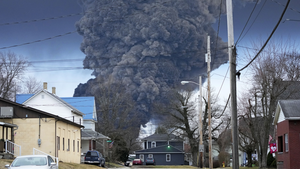 A black plume rises over East Palestine, Ohio, after a controlled release and incineration of chemicals from a derailed Norfolk Southern train on Feb. 6, 2023. (AP Photo/Gene J. Puskar)
A black plume rises over East Palestine, Ohio, after a controlled release and incineration of chemicals from a derailed Norfolk Southern train on Feb. 6, 2023. (AP Photo/Gene J. Puskar)
Before this weekend’s fiery Norfolk Southern train derailment prompted emergency evacuations in Ohio, the company helped kill a federal safety rule aimed at upgrading the rail industry’s Civil War-era braking systems, according to documents reviewed by The Lever.
Though the company’s 150-car train in Ohio reportedly burst into 100-foot flames upon derailing — and was transporting materials that triggered a fireball when they were released and incinerated — it was not being regulated as a “high-hazard flammable train,” federal officials told The Lever.
Documents show that when current transportation safety rules were first created, a federal agency sided with industry lobbyists and limited regulations governing the transport of hazardous compounds. The decision effectively exempted many trains hauling dangerous materials — including the one in Ohio — from the “high-hazard” classification and its more stringent safety requirements.
Amid the lobbying blitz against stronger transportation safety regulations, Norfolk Southern paid executives millions and spent billions on stock buybacks — all while the company shed thousands of employees despite warnings that understaffing is intensifying safety risks. Norfolk Southern officials also fought off a shareholder initiative that could have required company executives to “assess, review, and mitigate risks of hazardous material transportation.”
The sequence of events began a decade ago in the wake of a major uptick in derailments of trains carrying crude oil and hazardous chemicals, including a New Jersey train crash that leaked the same toxic chemical as in Ohio.
In response, the Obama administration in 2014 proposed improving safety regulations for trains carrying petroleum and other hazardous materials. However, after industry pressure, the final measure ended up narrowly focused on the transport of crude oil and exempting trains carrying many other combustible materials, including the chemical involved in this weekend’s disaster.
Then came 2017: After rail industry donors delivered more than $6 million to GOP campaigns, the Trump administration — backed by rail lobbyists and Senate Republicans — rescinded part of that rule aimed at making better braking systems widespread on the nation’s rails.
Specifically, regulators killed provisions requiring rail cars carrying hazardous flammable materials to be equipped with electronic braking systems to stop trains more quickly than conventional air brakes. Norfolk Southern had previously touted the new technology — known as Electronically Controlled Pneumatic (ECP) brakes — for its “potential to reduce train stopping distances by as much as 60 percent over conventional air brake systems.”
But the company’s lobby group nonetheless pressed for the rule’s repeal, telling regulators that it would “impose tremendous costs without providing offsetting safety benefits.”
That argument won out with Trump officials — and the Biden administration has not moved to reinstate the brake rule or expand the kinds of trains subjected to tougher safety regulations.
“Would ECP brakes have reduced the severity of this accident? Yes,” Steven Ditmeyer, a former senior official at the Federal Railroad Administration (FRA), told The Lever. “The railroads will test new features. But once they are told they have to do it… they don’t want to spend the money.”
Norfolk Southern did not answer questions about its efforts to weaken safety mandates. The company also did not answer questions about what kind of braking system was operating on the train that derailed in Ohio. The company referred The Lever to the National Transportation Safety Board, the federal agency that is investigating the accident and that had originally called for more expansive rules governing the transport of hazardous materials.
A spokesperson for one advocacy group pressing for tougher safety regulations said the Ohio disaster is the latest consequence of the rail industry’s cost-cutting, profit-at-all cost business model.
“Prior to the stock buyback era, railroads agreed that ECP brakes were a good thing,” said Ron Kaminkow, a longtime railroad worker and organizer with Railroad Workers United. “The railroads hadn’t yet come to the realization that they could do whatever they wanted. ECP brakes were on the drawing board, then off.”
“Fast As The Speed of Light”
The vast majority of the nation’s trains continue to rely on a braking system first developed in 1868. Trains equipped with these traditional air brakes make emergency stops more slowly and with higher rates of damage than trains equipped with ECP brakes, according to both safety advocates and the Federal Railroad Administration.
While air brakes stop train cars individually, as air pressure moves sequentially from one car to the next, ECP brakes operate using an electronic signal and can stop an entire train much faster.
As one railroad industry insider told The Washington Post anonymously in 2016: “Trains are like giant Slinkies. When you have that back of the train running into the front of the train, they can actually push cars out, cause a derailment and cause a hell of a mess.”
ECP braking, the analyst said, takes “the energy out of the train quicker, so when a train does derail there is less energy that has to be absorbed by crushing tank cars.”
Beginning in the 2000s, federal rail regulators pushed the rail industry to upgrade to electronic brakes that would lead to shorter stop times. After a 2006 technical report commissioned by the FRA concluded that ECP “could significantly enhance rail safety and efficiency,” the agency took the position of promoting widespread adoption of the technology.
The railroads, including Norfolk Southern, were initially outspoken advocates of the new equipment. Electronic brakes were so safe, the companies argued, that regulators could exempt upgraded trains from other safety mandates, saving time and money on frequent stops for safety inspections.
During a 2007 hearing before the Federal Railroad Administration, Donald Usak, manager of engineering for Norfolk Southern’s fleet, testified to the “big advantage for emergency braking” offered by the new systems.
“We all know the saying, ‘as fast as the speed of light,’” Usak said. “So does electricity travel at the speed of light. Signals from the engineer are at the rear of the train instantly. Signals initiated at any one of the vehicles in the train are throughout that train instantly.”
Later that year, when reporting its quarterly earnings, Norfolk Southern bragged to investors that it had “made railroad history” by equipping one of its trains exclusively with the new ECP technology and announced plans to add the safety feature to 30 more of its trains in the coming months.
But the industry abruptly changed its tune once regulators moved in 2014 to make the upgrades mandatory.
That year — after a series of high-profile rail accidents — the Pipeline and Hazardous Materials Safety Administration proposed a regulation requiring train cars carrying hazardous materials to be retrofitted with safety features, including ECP brakes, over a period of nearly a decade. The proposed regulation also imposed speed limits on trains carrying hazardous materials and required volatility tests for the substances being transported.
The railroad, oil, and chemical industries came out in full force against the regulation, arguing the new requirements would be disruptive and costly. The American Association of Railroads (AAR) — a lobbying group to which Norfolk Southern has long been a dues-paying member — in particular fought the ECP braking standards.
“AAR strongly opposes any requirement to use ECP brakes,” the association said in one of multiple comment letters on the rule. “ECP brakes would be extremely costly without providing an offsetting benefit… [the Federal Railroad Administration] assumed that business benefits would more than compensate for the costs of ECP brakes, but industry to this day has not identified business benefits that would justify transitioning to ECP brakes.”
Norfolk Southern also reported lobbying against “requiring ECP brakes” during the rule-making process. In 2015 legislative testimony, Norfolk Southern’s vice president Rudy Husband told Pennsylvania lawmakers that while the company planned to comply with the new rule, the “rail industry has serious concerns about the ECP brake requirements and the potential adverse impacts on the fluidity of the national freight rail network.”
A Hazard By Any Other Name
Alongside their campaign to kill the brake rule, industry lobbyists pushed to limit the types of chemical compounds that would be covered by new regulations, including the brake rule. They proposed limiting the definition of “high-hazard flammable trains,” or HHFT, mostly to cover oil trains — but not trains carrying the industrial chemical on the Norfolk Southern train that necessitated evacuations in Ohio.![]() Like politicians, regulators, companies and NGOs lying to us, saying there is no frac’ing here or there, but when one looks at regulator records, fracs are everywhere, just not yet “defined.”
Like politicians, regulators, companies and NGOs lying to us, saying there is no frac’ing here or there, but when one looks at regulator records, fracs are everywhere, just not yet “defined.”![]()
“It would be inappropriate to include those other flammable liquids in the rule without assessing how and in what quantities they are shipped, and what risks are associated with their transportation,” wrote the American Chemistry Council, which lobbies for chemical companies, in its letter asking regulators to limit the rule.
By contrast, the National Transportation Safety Board (NTSB), the federal agency tasked with investigating transportation accidents, argued for a broader definition of “high-hazard flammable trains.”
The agency pointed out that the industry’s own classifications of which hazardous materials should trigger more stringent safety precautions were broader than those in the proposed rule.
Citing an AAR memo on the topic, the NTSB wrote that “the railroad industry recognizes that additional safety precautions, including speed restrictions, are needed for key trains that transport any hazardous materials.”
The NTSB explicitly called for the rules to cover Class 2 flammable gases — a category that includes vinyl chloride, the chemical that was transported by the Ohio train that derailed.
Regulators also noted that “comments from the concerned public, local government, tribal communities, towns and cities voiced concern” that the industry’s proposed definitions of “high-hazard flammable trains” were too narrow — and some commenters “even suggested that a train consisting of one or more tank cars carrying crude oil or any other hazardous material should be classified as an HHFT.”
One mayor of a rail-trafficked Chicago suburb told regulators: “We support comments seeking to insure that all tank cars used in the transport of Class 2 flammable hazmat, not only those in HHFT’s, will be covered by the agencies’ new rules.”
“The Costs Of The ECP Rule Substantially Outweigh Its Benefits”
In 2015, the Obama administration issued the new transportation rule, which was far less stringent and wide-ranging than safety advocates had demanded. The final regulation’s definition of “high-hazard flammable trains” was not expanded as the NTSB requested, and the regulations applied only to trains with more than 20 of cars in a single block carrying hazardous materials, or 35 located throughout the train.
However, the rule did require ECP braking for the subset of rail cars that would still be classified as “high-hazard flammable trains” — an important step in pushing the rail industry to expand its use of the braking technology.
Though the rule was limited in scope, industry groups nonetheless lambasted the ECP braking requirements.
“I have a hard time believing the determination to impose ECP brakes is anything but a rash rush to judgment,” the president of the AAR said about the new rule.
Obama-era regulators disagreed.
“The mission of the FRA is safety and not focusing on what is convenient or inexpensive or provides the most cost savings for the rail industry,” said Sarah Feinberg, the FRA administrator at the time, about the new rule. “When I focus on safety, I land on ECP. It’s a very black-and-white issue for me.”
Soon after the rule’s enactment, the railroad industry took the matter to Congress and found allies in Senate Republicans, after an election cycle that saw rail industry donors dump $6 million into GOP campaign coffers.
Sen. John Thune (R-S.D.) — the Senate’s third largest recipient of rail industry campaign cash — pushed to repeal the electronic braking rule outright, before settling for a measure requiring additional research and a new cost-benefit analysis of the technology. Under former President Donald Trump, the braking upgrades quickly became another casualty of his administration’s slash-and-burn approach to regulatory policy.
While the Obama administration had estimated that the rule could save more than $1 billion by averting accidents, the Trump administration rolled out new figures that cut the estimated benefits by a third.
The AAR lobbying group concurred that “the costs of the ECP rule substantially outweigh its benefits,” and claimed the mandate would cost them about $3 billion — or roughly 2 weeks of their operating revenue in a typical year. The FRA estimated the brake requirement would cost about half a billion.
Trump’s Transportation Department ultimately rescinded the brake rule in late 2017.
Thune praised the decision in a statement arguing that “sound science and careful study” had won the day.
But a 2018 investigation from the Associated Press revealed that the Trump Transportation Department had flubbed its calculations. By excluding the most common type of train derailments, the government’s analysis omitted at least $117 million in estimated future damages when it revised the rule’s potential benefits to justify its repeal.
The agency acknowledged the error and issued a technical correction to its analysis, but said that the expense was still too great to reinstate the ECP brake rule.
“It Defies Logic”
Fast forward a few years, and the same matters debated during the formulation of the safety rule appear to be at issue in Ohio.
There, the derailed Norfolk Southern train was carrying flammable and carcinogenic vinyl chloride — a class 2 flammable gas — as well as other gases and “combustible liquids,” according to the company.
Government officials asked residents living within a mile of the accident to evacuate, warning that the flammable materials in the rail cars could explode and launch “deadly shrapnel as far as a mile.” As a result, crews on Monday released the vinyl chloride and burned it, creating a toxic mushroom cloud.
And yet, federal officials told The Lever that the train was not classified as a “high-hazard flammable train,” under the more limited definition outlined by the 2015 Obama rule.
“The train did not qualify as an HHFT under the regulations,” said an NTSB spokesperson. An FRA spokesperson seconded that.
“The definition of an HHFT is too narrow if it does not include a train like the one that derailed last Friday [in] East Palestine, Ohio,” Ditmeyer, the former FRA official, told The Lever. “In fact, it defies logic that the train was not defined as an HHFT.”
According to federal investigators, the derailment was caused by a mechanical issue with a rail car axle. Ditmeyer and two other experts told The Lever that ECP braking probably would have reduced the damage caused by the derailment by bringing the train to a halt more quickly and stopping all of the cars simultaneously.
“If the axle breaks, it’s almost certain that the train is going to derail,” said John Risch, a former BNSF engineer and national legislative director for the Sheet Metal, Air, Rail, and Transportation Union. “ECP brakes would help to bring the train to a stop. What they do is activate the brakes on each car at the same time immediately. That’s significant: When you apply the brakes on a conventional train, they brake from the front to the rear. The cars bunch up.”
Risch said that ECP brakes are the “most remarkable advancement” he ever encountered in his 31-year career as a railroad worker, adding: “It needs to be implemented.”
But instead of investing in the safety feature, the seven largest freight railroad companies in the U.S., including Norfolk Southern, spent $191 billion on stock buybacks and shareholder dividends between 2011 and 2021, far more than the $138 billion those firms spent on capital investments in the same time period.
The same companies also slashed their workforces by nearly 30 percent in that timeframe as part of what they called “precision scheduled railroading.” Such staffing cuts are likely contributing to safety issues in freight railways. In a recent investor presentation, Norfolk Southern disclosed an increase in train accidents over the past three consecutive years.
“The massive reduction in the workforce, attendance policies that encourage people to come to work when they’re sick or exhausted, lack of access to [paid] leave, the stress that is constantly put on workers because of how lean the workforce has become, it creates a negative culture in terms of safety,” Greg Regan, president of the Transportation Trades Department of the AFL-CIO, told The Lever.
Last fall, President Joe Biden and Congress helped the industry crush an effort by rail workers to win paid sick leave by intervening to block a strike.
As the industry has resisted safety measures and shed staff, rail companies have increased the length of trains. Norfolk Southern was the leader in this category as of 2021, with an average train length of over 7,000 feet — which is 1.3 miles, or more than 100 rail cars. The Norfolk Southern train that derailed in Ohio was 9,300 feet long, or nearly 1.8 miles.
“Our push for efficiency led to record train weight and record train length in the quarter,” a Norfolk Southern executive bragged on a 2021 earnings call.
Concerns about train length and public safety prompted federal funding for a study on the issue in the 2021 infrastructure bill. On Tuesday, residents of East Palestine filed suit against Norfolk Southern in a U.S. District Court, alleging negligence.
email hidden; JavaScript is required:
Volumes could, and should be written about this. Must we spend our entire lives being victims of corporate greed and mismanagement? As someone living in Northeast Ohio, I do hope that the people of E. Palestine show up at City Hall, as well as the courts as we must do each time our lives are threatened by powerful interests. Thank you so much for the newsletter and your work, David. Yours and your exemplary team. it is such an important part of my day and understanding.
If one community were to pass a law stating that these trains could not go through town without these brakes and safety precautions, enacted, it may be a game changer.
North Lima woman finds chickens dead Tuesday, questions chemical release from train by Nadine Grimley, Feb 7, 2023, WKBN
Excellent Video.
NORTH LIMA, Ohio (WKBN) – People across the Mahoning Valley — including those who live in Mahoning and Trumbull counties — reported smelling chlorine after Monday’s controlled release in East Palestine. Officials said it wasn’t dangerous![]() That’s what officials always say, in Canada too, even when they know industrial releases/accidents/intentional releases are life threatening
That’s what officials always say, in Canada too, even when they know industrial releases/accidents/intentional releases are life threatening![]() , but one North Lima woman is skeptical about that statement.
, but one North Lima woman is skeptical about that statement.
Even though North Lima is a little more than 10 miles away from East Palestine, Amanda Breshears said the smell caused her eyes to water when she went to let her dog out. She believes it could be the reason why her birds are now dead.
Breshears was going to feed her five hens and rooster Tuesday morning when she discovered them all lifeless, practically in the same position, with no signs of a predator entering their enclosure.
“I’m beyond upset and quite panicked, ’cause this, they may be just chickens, but they’re family,” she said.
Breshears said her chickens were alive and well on Monday.
She believes that the smell following the detonation of the train carrying chemicals that derailed in East Palestine is to blame for her birds’ sudden death.
“My video camera footage shows my chickens were perfectly fine before they started this burn, and as soon as they started the burn, my chickens slowed down and they died,” she said.
“If it can do this to chickens in one night, imagine what it’s going to do to us in 20 years,” she added. Photo Gallery: Train derailment fire in East Palestine
Officials have said that the smell wasn’t toxic or dangerous but still advised people in the Mahoning Valley to stay indoors Monday night as a precaution.
“For them to say the air quality is OK, I’m calling B.S.,” she said.

![]() Me too. Officials told us at Rosebud our life threatening drinking water was perfectly natural and safe (contaminated after Encanaa/Ovintiv intentionally illegally frac’d it) even after our water manager was seriously injured and hospitalized after our community water tower was destroyed in an explosion from accumulated gases (purpose of frac’ing is to release methane and ethane, etc). Pffft. High paid Slick liars.
Me too. Officials told us at Rosebud our life threatening drinking water was perfectly natural and safe (contaminated after Encanaa/Ovintiv intentionally illegally frac’d it) even after our water manager was seriously injured and hospitalized after our community water tower was destroyed in an explosion from accumulated gases (purpose of frac’ing is to release methane and ethane, etc). Pffft. High paid Slick liars.![]()
Breshears said she is going to be taking the birds to a veterinarian to have them examined in the hopes of holding someone responsible for their deaths.
Sources said this is not the only incident like this that they have heard of in the past day, however, those at the Ohio Department of Agriculture said they haven’t heard of any problems.
The Department of Agriculture released the following statement on Tuesday.
“The Ohio Department of Agriculture (ODA) is assuring Ohioans its food supply is safe and the risk to livestock remains low following the East Palestine train derailment.

ODA has not received any reports regarding the wellness of animals related to the incident. As the Ohio EPA and area agencies continue to monitor the air and water quality, ODA is ready to assist as needed.
If you notice unusual behavior in your livestock or domestic pet, please contact your local veterinarian for further guidance.”


Trump Rolls Back Train-Braking Rule Meant to Keep Oil Tankers from Exploding Near Communities by Glenn Fleishman, September 24, 2018, Fortune
Trains that carry oil and other flammable material won’t have to install electronically controlled brakes that reduce the risk of train derailments and explosions after the reversal by Trump officials of an Obama-era safety rule.
The Pipeline and Hazardous Materials Safety Administration (PHMSA) posted the rule change today at its Web site, arguing that the cost of installing these more sophisticated brakes outweighs the benefit. The reversal was first proposed in December 2017, around the time of a deadly Amtrak derailment in Washington State, and finalized today. The improved brakes had a 2021 deadline for installation until the industry-supported change.
About 20 derailments of trains carrying oil and ethanol that have led to spills, fires, and, in some cases, evacuations have occurred since 2010 in the U.S. and Canada. Riverkeeper, a clean-water advocacy group, compiled video reports from many of the accidents.
U.S. trains rely on pneumatic braking technology first invented in the 1860s, in which continuous air pressure linked from the front of the train keeps a brake from engaging on wheels on each car. When an engineer applies braking, it can take several seconds for pneumatic pressure to drop to the end of a 100-car train, and trains can be longer.
Electronically controlled pneumatic (ECP) brakes still use air pressure, but each car has an individual braking control which receives an electronic signal simultaneously, reducing the danger of derailment when cars slam into the preceding ones before braking themselves.
The seconds’ difference between regular and ECP brakes is where the battle lies for this regulations. The railroad industry claims it would cost more than $3 billion to install necessary ECP on trains used for flammable liquids, while the Federal Railroad Administration under President Barack Obama said it would be about half a billion.

Refer also to:
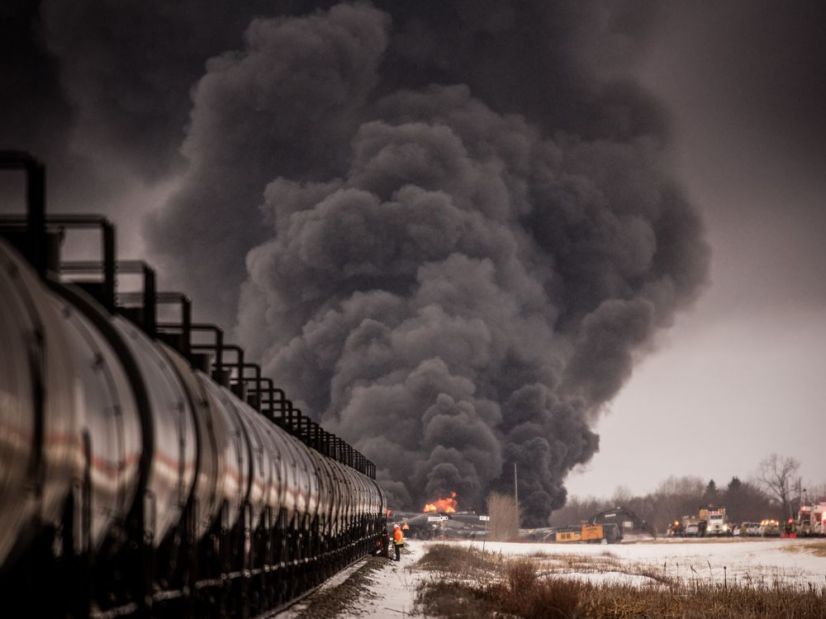

Study shows Lac-Mégantic disaster left fish in Chaudière River with major anomalies
Lac-Mégantic lacks control over what ships through town
Transport Canada ‘not aware’ of crude’s risks before Lac-Mégantic disaster
Federal agency did not know U.S. regulators raised warning signs four months before accident that crude being shipped by train was highly explosive and unusually corrosive
Why towns are powerless to stop another disaster like Lac-Mégantic
Here’s the main reason, our courts: Judge rules CP not liable for Lac-Megantic deadly frac’d oil train crash. Status quo wins again. Soon, there will be no ordinary people left for the rich to rape, pillage and murder.
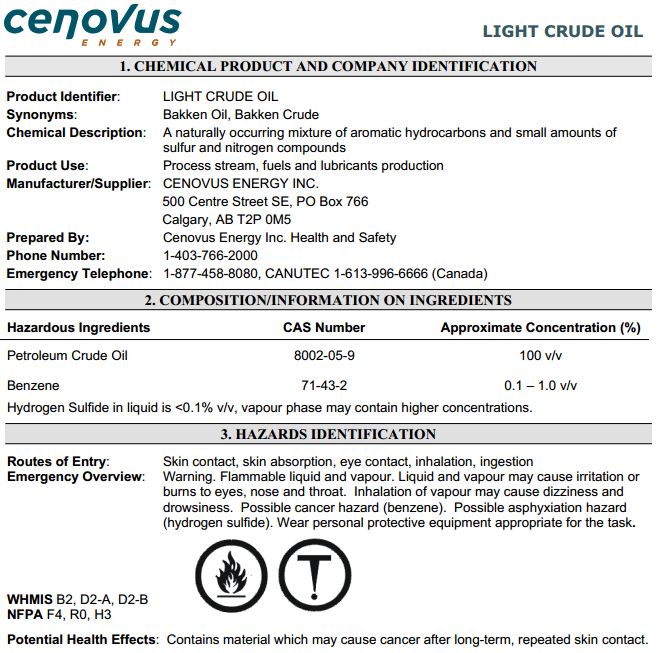
Recent fact-finding mission to Bakken oil field paid little attention to environmental concerns
How frac’d oil from the U.S. Bakken formation decimated Lac-Mégantic
